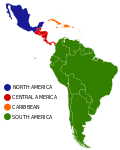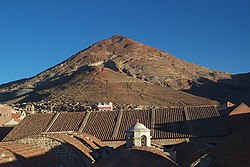Latin America
Latin America is the part of the Americas where the people speak Romance languages. This includes most of South America and Central America (also including the Spanish and French-speaking Caribbean islands).
 | |
| Area | 20,111,457 square kilometers (7,765,077 square miles)[1] |
|---|---|
| Population | 639,048,639 (2016 estimate)[2][a] |
| Population density | 31 per square kilometer (80 per square mile) |
| Demonym | Latin American |
| Countries | 20[b] |
| Dependencies | 13 |
| Languages | Mainly: Spanish, Portuguese, and French Others: English, Dutch, Papiamento |
| Time zones | UTC−2 to UTC−8 |
| Largest cities | (Metro areas)[3][4] 1. São Paulo 2. Mexico City 3. Buenos Aires 4. Lima 5. Rio de Janeiro 6. Bogotá 7. Santiago 8. Belo Horizonte 9. Guadalajara 10. Monterrey |
| UN M49 code | 419 – Latin America019 – Americas001 – World |
The places in the Americas which speak French (French Guiana, Haiti, Quebec and the French-speaking Caribbean islands) are not always included as a part of Latin America, although French is also a Romance language.[5]
Latin America has vibrant artistic and cultural traditions. Latin American literature, music, and arts are world famous.[6]
In the United States, the term "Latino" refers to a person who has Latin American heritage. It is different from Hispanic which would only include countries where Spanish is the official language. For example, Hispanic would not include Brazil because its official language is Portuguese.
In Spanish, "latino" is a masculine term (for boys and men) whereas "latina" is a feminine term (for girls and women). In the English language, "latino" is not associated with gender so it is an all-inclusive term (male, female, and non-binary). In the 2010s, the term "Latinx" was created to be a gender-neutral term but very few Latinos actually use it.[7]
Countries and territories that make up Latin America
Spanish-speaking
Portuguese-speaking
French-speaking
Creole-speaking
Demographics
| Historical populations | ||
|---|---|---|
| Year | Population | ±% |
| 1750 | 16,000,000 | — |
| 1800 | 24,000,000 | +50.0% |
| 1850 | 38,000,000 | +58.3% |
| 1900 | 74,000,000 | +94.7% |
| 1950 | 167,000,000 | +125.7% |
| 1999 | 511,000,000 | +206.0% |
| 2013 | 603,191,486 | +18.0% |
| Source: "UN report 2004 data" (PDF) | ||
Largest cities
The following is a list of the ten largest metropolitan areas in Latin America.[3]
| City | Country | 2017 population | 2014 GDP (PPP, $million, USD) | 2014 GDP per capita, (USD) |
|---|---|---|---|---|
| Mexico City | 23,655,355 | $403,561 | $19,239 | |
| São Paulo | 23,467,354 | $430,510 | $20,650 | |
| Buenos Aires | 15,564,354 | $315,885 | $23,606 | |
| Rio de Janeiro | 14,440,345 | $176,630 | $14,176 | |
| Bogotá | 9,900,800 | $199,150 | $19,497 | |
| Lima | 9,752,000 | $176,447 | $16,530 | |
| Santiago | 7,164,400 | $171,436 | $23,290 | |
| Belo Horizonte | 6,145,800 | $95,686 | $17,635 | |
| Guadalajara | 4,687,700 | $80,656 | $17,206 | |
| Monterrey | 4,344,200 | $122,896 | $28,290 |
Ethnic groups
People in Latin America are part of several ethnic groups and races. The majority of Latin Americans are Mestizo and some others are White, Mulatto, Black, Zambo, and Asian.
- Native American or indigenous. The Native population in Latin America, came during the Lithic stage. There are more than sixty million of these people. They are the majority only in Bolivia, Peru, and Guatemala. In Ecuador they are a large minority of about 1/4 of the population. Mexico's Native American population is nearly 30%, and is also one of the largest American Indian population in the Americas in terms of absolute numbers. Most of the remaining countries have Native American minorities.
- European. In the 1500s, many Iberian colonists came to what is now Latin America. Today, most White Latin Americans are of Spanish and Portuguese origin. The Iberians brought their languages, religion, and cultures to Latin America.
- African. Millions of African slaves were brought to the Americas from the early 1500s onward. The majority were sent to the Caribbean and Brazil.
- Asian. People of Asian descent number several millions in Latin America. The majority of Asian Latin Americans are of Japanese and Chinese heritage, and they mostly live in Peru and Brazil. The largest community of Japanese ethnicity living outside of Japan, resides in Brazil. There is also a growing Chinese population in Panama, as well as Costa Rica (though, Chinese Costa Ricans are a large minority). In the Dominican Republic, there is a place where large numbers of Japanese people came; most Japanese Dominicans live in towns such as Bonao and Santo Domingo.
- Arab or Middle Eastern. Arabs in Latin America are also many, but they are mostly found among the Hispanic-Caribbean regions. In Cuba and Puerto Rico. In the Dominican Republic, the Arabs arrived sometime between the 19th and 20th century; (most are Moroccans and Lebanese).
Most of these ethnic groups can be found anywhere in Latin America; but since most Latin Americans are of mixed-race, many of these ethnic groups do not reach 100%.
| Country | Population | American Indians | Whites | Mestizos | Mulattoes | Blacks | Zambos | Asians |
|---|---|---|---|---|---|---|---|---|
| 40,134,425 | 1.0% | 85.0% | 11.1% | 0.0% | 0.0% | 0.0% | 2.9% | |
| 10,907,778 | 55.0% | 13.0% | 30.0% | 2.0% | 0.0% | 0.0% | 0.0% | |
| 192,272,890 | 0.4% | 47.7% | 46.8% | 0% | 7.6% | 0.0% | 1.1% | |
| 17,063,000 | 6.2% | 60.7% | 34.1% | 0.0% | 0.0% | 0.0% | 0.0% | |
| 45,393,050 | 2.0% | 38% | 48% | 0.0% | 10.6% | 0.0% | 0.0% | |
| 4,253,897 | 2.4% | 82.0% | 10.3% | 2.0% | 1.0% | 0.0% | 2.3% | |
| 11,236,444 | 0.0% | 34.3% | 0.0% | 35.4% | 30.3% | 0.0% | 1.0% | |
| 8,562,541 | 0.0% | 16.4% | 30.0% | 37.7% | 21.5% | 2.0% | 0.4% | |
| 13,625,000 | 38.0% | 10.3% | 41.0% | 5.0% | 6.6% | 0.0% | 0.1% | |
| 6,134,000 | 2.0% | 11.0% | 87.0% | 0.0% | 0.0% | 0.0% | 0.0% | |
| 13,276,517 | 43.0% | 16.0% | 40.0% | 0.2% | 0.0% | 0.0% | 0.8% | |
| 7,810,848 | 7.7% | 5.0% | 82.9% | 1.7% | 0.0% | 2.0% | 0.7% | |
| 112,322,757 | 14.0% | 15.0% | 68.1% | 0.5% | 2.4% | 0.0% | 0.5% | |
| 5,891,199 | 9.0% | 17.0% | 69.0% | 5.0% | 0.0% | 0.0% | 0.2% | |
| 3,322,576 | 8.0% | 14.0% | 51.0% | 13.0% | 5.0% | 3.0% | 6.0% | |
| 6,349,000 | 1.5% | 25.0% | 69.5% | 3.5% | 0.0% | 0.0% | 0.5% | |
| 29,461,933 | 45.0% | 15.2% | 32.0% | 4.5% | 0.0% | 0.0% | 3.3% | |
| 3,967,179 | 2.0% | 72.1% | 13.0% | 6.7% | 6.0% | 0.0% | 0.2% | |
| 3,494,382 | 0.0% | 88.0% | 8.0% | 2.0% | 2.0% | 0.0% | 0.0% | |
| 26,814,843 | 1.6% | 42.9% | 43.3% | 7.7% | 2.3% | 0.0% | 2.2% | |
| Total | 561,183,291 | 9.2% | 39.1% | 33.3% | 14.3% | 3.2% | 0.2% | 0.7% |
Note: Puerto Rico is a territory of the United States.
Language
Spanish and Portuguese are the most common languages in Latin America. Portuguese is the official language of Brazil, while Spanish is the official language of most other Latin America mainland countries, and of Cuba, Puerto Rico (along with English), and the Dominican Republic.
Many people speak Native American languages in Peru, Guatemala, Bolivia, Paraguay and Mexico. These languages are less common in other countries, but in some countries like Bolivia, they are considered official along with the main European language.
Other Indo-European languages spoken in Latin America include English (spoken in Guyana, in several Caribbean countries and territories, and by a very small minority in Puerto Rico), French (spoken in French Guiana, Haiti and in the French Caribbean territories), and Dutch (in Suriname). Although French is also spoken in the Canadian province of Quebec and the American state of Louisiana, these countries are not considered part of Latin America, because they are mostly English-speaking. Guyana, French Guiana (one of the overseas territories of France), and Suriname, which are found the northern part of South America and known together as the Guianas, are the only places in South America that do not speak Spanish or Portuguese.
Some African languages are also spoken in Latin America. The west African Yoruba language (known as Lucumi) is spoken in Cuba, where it is a ritual language used by the Santeria prayers.
In several nations, Creole languages are also spoken, especially in the Caribbean. Palenquero is the Spanish-based Creole language spoken in Colombia by some 3,000 people, it is Spanish with many African influences and some Portuguese influence. Other creoles in mainland Latin America have the same roots, blending Spanish with either African or Indigenous languages or both, as Cuban Spanish does. The island of Haiti also has a well-known creole language, called Haitian Creole.
Religions
Most Latin Americans are Christians. A 2014 survey found that 69% of Latin Americans are Roman Catholic, while 17% are Protestants. Most Protestants are from Brazil or Central America.
Economy
Poverty and inequality
Poverty continues to be one of the biggest challenges for Latin American countries. According to estimates, Latin America is the most unequal region of the world. According to a Country Studies Institute the poorest countries in the region (in 2011) were: Haiti, Nicaragua, Bolivia and Honduras. Undernourishment affects 72% of Haitians, 47% of Nicaraguans and Bolivians, and 32% of Hondurans.
Also, according to the Country Studies Institute, over 90% of Haitians, 75% of Bolivians, 70% of Nicaraguans, and 63% of Hondurans live in poverty.
Latin America Media
Mayan UNESCO World Heritage Site of Chichén Itzá
UNASUR summit in the Palacio de la Moneda, Santiago de Chile
Soybean plantation in Mato Grosso. In 2020, Brazil was the world's largest producer, with 130 million tons. Latin America produces half of the world's soybeans.
Cerro Rico, Potosi, Bolivia, still a major mine
Braskem, the largest Brazilian chemical industry
EMS, the largest Brazilian pharmaceutical industry
Steel production in San Nicolás, Argentina.
Related pages
Notes
- ↑ Includes the population estimates for South American and Central American countries, not including Belize, Guyana, the United States, and Spanish and French-speaking Caribbean countries and territories.
- ↑ Not including Anglophone or Dutch-speaking countries, such as Belize, Guyana, Jamaica, Suriname and Trinidad and Tobago; see Contemporary definitions section
- ↑ Note: Puerto Rico is a territory of the
 United States.
United States.
- ↑ Note: French Guiana is an overseas department of
 France.
France.
- ↑ Note: Guadeloupe is an overseas department of
 France.
France.
- ↑ Note: Martinique is an overseas department of
 France.
France.
- ↑ Note: Saint Barthélemy is an overseas collectivity of
 France.
France.
- ↑ Note: Saint Martin is an overseas collectivity of
 France.
France.
- ↑ Note: Saint Pierre and Miquelon is an overseas collectivity of
 France
France
- ↑ Note: Quebec is a province of
 Canada
Canada
References
- ↑ "World Development Indicators: Rural environment and land use". World Development Indicators, The World Bank. World Bank. Retrieved September 12, 2013.
- ↑ "World Population Prospects: The 2017 Revision". ESA.UN.org (custom data acquired via website). United Nations Department of Economic and Social Affairs, Population Division. Retrieved 10 September 2017.
- ↑ 3.0 3.1 "Global Metro Monitor 2014". Brookings Institution. 30 November 2001. Retrieved 22 January 2015.
- ↑ Geography Department at Loughborough University, The World According to GaWC 2012 Archived 2014-03-20 at the Wayback Machine, Table 4
- ↑ Colburn, Forrest D (2002). Latin America at the End of Politics. Princeton University Press. ISBN 978-0-691-09181-5.
- ↑ "Latin American literature". Encyclopedia Britannica. Retrieved 2021-07-31.
- ↑ ""Latinx" is Unpopular with Actual Latin Americans, Poll Shows".
- ↑ Lizcano Fernández, Francisco (May–August 2005). "Composición Étnica de las Tres Áreas Culturales del Continente Americano al Comienzo del Siglo XXI" (PDF). Convergencia (in Spanish). Mexico: Universidad Autónoma del Estado de México, Centro de Investigación en Ciencias Sociales y Humanidades. 38: 185–232, table on p. 218. ISSN 1405-1435. Archived from the original (PDF) on 2014-02-24. Retrieved 2012-09-06.
{{cite journal}}: CS1 maint: unrecognized language (link)
Other websites
| Wikimedia Commons has media related to Lua error in Module:Commons_link at line 62: attempt to index field 'wikibase' (a nil value).. |
- Latin America – Citizendium
- The Washington Post Interactive Map of Politics in Latin America
- Andean Community official webpage Archived 2008-05-09 at the Wayback Machine
- Council on Hemispheric Affairs
- Latin American Network Information Center Archived 2007-12-24 at the Wayback Machine
- Latin America Working Group
- Washington Office on Latin America
- Politics in Latin America
- Infolatam. Information and analysis of Latin America Archived 2008-09-08 at the Library of Congress Web Archives









